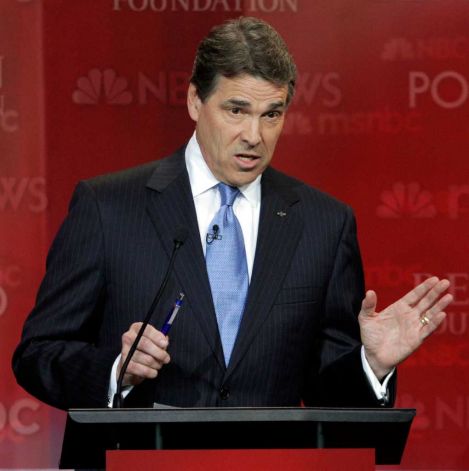Perry Trusts Scientists, if They Help Him Win

Rick Perry may think his opinions on climate change makes him a modern day Galileo, but there is one field where he is willing to concede ground to the experts: the political science of how to run a campaign.
Political scientists who study elections are interested to measuring the effectiveness of campaign tactics and strategies quantitatively. They ask questions like: “does it make a difference how a candidate spends his money?” or “how many votes did a candidate gain by using this campaign method?”
Rick Perry doesn’t have an interest in the latest theories in the field but he does have an interest in winning. Sasha Issenberg reports on this with his article “Rick Perry and His Eggheads”. The article is currently available on Amazon and is an excerpt from a book he is writing about political science and modern campaigns.
In 2006, Rick Perry and his campaign staff decided to give a small group of political scientists complete freedom to study and experiment on his 2006 gubernatorial campaign. Issenberg tells the New York Times what happened:
As the 2006 election season approached, the governor’s top strategist, Dave Carney, invited four political scientists into Perry’s war room and asked them to impose experimental controls on any aspect of the campaign budget that they could randomize and measure. Over the course of that year, the eggheads, as they were known within the campaign, ran experiments testing the effectiveness of all the things that political consultants do reflexively and we take for granted: candidate appearances, TV ads, robocalls, direct mail. These were basically the political world’s version of randomized drug trials, which had been used by academics but never from within a large-scale partisan campaign.
The findings from those 2006 tests dramatically changed how Carney prioritized the candidate’s time and the campaign’s money when Perry sought re-election again in 2010 and will inform the way he runs for president now.
One result? Perry’s campaign did more retail politics to gain the approval of local media:
Perry just got much better press when he was in Lubbock or Beaumont than when newspapers and TV stations there relied on stories out of Austin, which tended to be much more cynical or negative. As a result, Carney came to appreciate that such an afternoon might be more effectively spent by having Perry fly to just one of the markets and appear personally there.
By 2010, the campaign operated under the principle that having Perry set foot in a coffee shop or BBQ restaurant — even if there was only a small crowd to witness it in person — was the best media strategy available.
Abby Rapoport reports on another change for Perry's 2010 campaign, the campaign paid no attention to yard signs and focused entirely on metrics that would increase turnout:
When people heard that Rick Perry's 2010 gubernatorial campaign wouldn't have yard signs, political wonks considered it a form of heresy. Supporters could buy yard signs for $7.99, just like they could buy buttons ($2.89) and bumper stickers ($1.99). But the campaign hardly cared if supporters chose to give a a few dollars to show some support.
Instead, from beginning to end, the entire race focused on turnout. Rather than making phone calls and wearing Perry t-shirts, would-be supporters were asked to do something very, very specific: turn out 12 Perry votes from their friends and family.
A national campaign is different from running for reelection in Texas, but his willingness to cede ground to experts in this field gives Perry an advantage.
Perhaps the real lesson is this: scientists can get Perry to believe in climate change if they can convince him that their research will lower taxes and win him elections. Even he would be surprised by how quickly his opinion changes.

